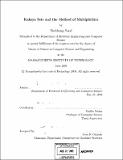Kakeya sets and the method of multiplicities
Author(s)
Saraf, Shubhangi
DownloadFull printable version (1.918Mb)
Other Contributors
Massachusetts Institute of Technology. Dept. of Electrical Engineering and Computer Science.
Advisor
Madhu Sudan.
Terms of use
Metadata
Show full item recordAbstract
We extend the "method of multiplicities" to get the following results, of interest in combinatorics and randomness extraction. 1. We show that every Kakeya set (a set of points that contains a line in every direction) in F' must be of size at least qn/2n. This bound is tight to within a 2 + o(1) factor for every n as q -- oc, compared to previous bounds that were off by exponential factors in n. 2. We give improved randomness extractors and "randomness mergers". Mergers are seeded functions that take as input A (possibly correlated) random variables in {0, 1}N and a short random seed and output a single random variable in {0, 1}N that is statistically close to having entropy (1 - 6) - N when one of the A input variables is distributed uniformly. The seed we require is only (1/6) - log A-bits long, which significantly improves upon previous construction of mergers. 3. Using our new mergers, we show how to construct randomness extractors that use logarithmic length seeds while extracting 1- o(1) fraction of the min-entropy of the source. The "method of multiplicities", as used in prior work, analyzed subsets of vector spaces over finite fields by constructing somewhat low degree interpolating polynomials that vanish on every point in the subset with high multiplicity. The typical use of this method involved showing that the interpolating polynomial also vanished on some points outside the subset, and then used simple bounds on the number of zeroes to complete the analysis. Our augmentation to this technique is that we prove, under appropriate conditions, that the interpolating polynomial vanishes with high multiplicity outside the set. This novelty leads to significantly tighter analyses.
Description
Thesis (S.M.)--Massachusetts Institute of Technology, Dept. of Electrical Engineering and Computer Science, 2009. Cataloged from PDF version of thesis. Includes bibliographical references (p. 51-53).
Date issued
2009Department
Massachusetts Institute of Technology. Department of Electrical Engineering and Computer SciencePublisher
Massachusetts Institute of Technology
Keywords
Electrical Engineering and Computer Science.